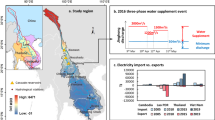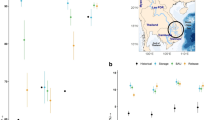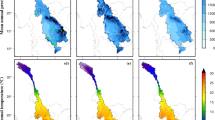Abstract
The Lancang-Mekong River Basin is facing booming water resources infrastructure development, long-term transboundary conflicts and trade-offs between economic goals and ecosystem services provision. Optimizing the pathway towards sustainable infrastructure operation has lacked multisector-coordinated and decision behaviour-based perspectives for transboundary water systems. In this study we quantified how, and to what extent, transboundary cooperation generates economic and environmental co-benefits by jointly using a coupled simulation–optimization approach and cooperative game theoretical analysis. We found that full cooperation outweighs partial or non-cooperation modes to promote economic benefits by 3 to 21% and to minimize the losses in fishery and sediment transport from 23% and 60% to 12% and 22%, respectively. Full cooperation becomes more beneficial and stable alongside infrastructure expansion, climate change and satisfying the hydrological needs of river ecosystems. These findings underscore the importance of full cooperation for sustaining socio-environmental systems and highlight the need for a benefit reallocation mechanism and designed flow management to stabilize basin-level full cooperation in the Lancang-Mekong River Basin.
This is a preview of subscription content, access via your institution
Access options
Subscribe to this journal
Receive 12 digital issues and online access to articles
$119.00 per year
only $9.92 per issue
Buy this article
- Purchase on SpringerLink
- Instant access to full article PDF
Prices may be subject to local taxes which are calculated during checkout




Similar content being viewed by others
Data availability
All of the data needed to replicate our results are available in the article, online or in the Supplementary Information.
Code availability
All of the codes used in this study can be provided by the corresponding authors upon request.
Change history
13 June 2024
A Correction to this paper has been published: https://doi.org/10.1038/s44221-024-00273-y
References
Winemiller, K. O. et al. Balancing hydropower and biodiversity in the Amazon, Congo, and Mekong. Science 351, 128–129 (2016).
Winsemius, H. C. et al. Global drivers of future river flood risk. Nat. Clim. Change 6, 381–385 (2016).
Sadoff, C. W. & Grey, D. Beyond the river: the benefits of cooperation on international rivers. Water Policy 4, 389–403 (2002).
Poff, N. L. et al. Sustainable water management under future uncertainty with eco-engineering decision scaling. Nat. Clim. Change 6, 25–34 (2016).
Poff, N. L. & Schmidt, J. C. How dams can go with the flow. Science 353, 1099–1100 (2016).
Poff, N. L. & Olden, J. D. Can dams be designed for sustainability? Dam design on the Mekong River can help to support water, energy, and fisheries needs. Science 358, 1252–1253 (2017).
Almeida, R. M. et al. Strategic planning of hydropower development: balancing benefits and socioenvironmental costs. Curr. Opin. Environ. Sustain. 56, 101175 (2022).
Flecker, A. S. et al. Reducing adverse impacts of Amazon hydropower expansion. Science 375, 753–760 (2022).
Schmitt, R. J., Bizzi, S., Castelletti, A., Opperman, J. J. & Kondolf, G. M. Planning dam portfolios for low sediment trapping shows limits for sustainable hydropower in the Mekong. Sci. Adv. 5, eaaw2175 (2019).
Schmitt, R. J. P., Bizzi, S., Castelletti, A. & Kondolf, G. M. Improved trade-offs of hydropower and sand connectivity by strategic dam planning in the Mekong. Nat. Sustain. 1, 96–104 (2018).
Schmitt, R. J. et al. Strategic basin and delta planning increases the resilience of the Mekong Delta under future uncertainty. Proc. Natl Acad. Sci. USA 118, e2026127118 (2021).
Yu, Y., Zhao, J., Li, D. & Wang, Z. Effects of hydrologic conditions and reservoir operation on transboundary cooperation in the Lancang–Mekong River Basin. J. Water Resour. Plan. Manag. 145, 04019020 (2019).
Giuliani, M. & Castelletti, A. Assessing the value of cooperation and information exchange in large water resources systems by agent-based optimization. Water Resour. Res. 49, 3912–3926 (2013).
Pastor, A. V. et al. The global nexus of food–trade–water sustaining environmental flows by 2050. Nat. Sustain. 2, 499–507 (2019).
Ziv, G., Baran, E., Nam, S., Rodríguez-Iturbe, I. & Levin, S. A. Trading-off fish biodiversity, food security, and hydropower in the Mekong River Basin. Proc. Natl Acad. Sci. USA 109, 5609–5614 (2012).
Zhang, B. et al. Dual water-electricity cooperation improves economic benefits and water equality in the Lancang-Mekong River Basin. Nat. Commun. 14, 6228 (2023).
Hensengerth, O. Transboundary river cooperation and the regional public good: the case of the Mekong River. Contemp. Southeast Asia 31, 326–349 (2009).
Chen, W. & Olden, J. D. Designing flows to resolve human and environmental water needs in a dam-regulated river. Nat. Commun. 8, 2158 (2017).
Sabo, J. L. et al. Designing river flows to improve food security futures in the Lower Mekong Basin. Science 358, eaao1053 (2017).
Gao, J., Castelletti, A., Burlado, P., Wang, H. & Zhao, J. Soft-cooperation via data sharing eases transboundary conflicts in the Lancang-Mekong River Basin. J. Hydrol. 606, 127464 (2022).
Momblanch, A., Connor, J. D., Crossman, N. D., Paredes-Arquiola, J. & Andreu, J. Using ecosystem services to represent the environment in hydro-economic models. J. Hydrol. 538, 293–303 (2016).
Darby, S. E. et al. Fluvial sediment supply to a mega-delta reduced by shifting tropical-cyclone activity. Nature 539, 276–279 (2016).
Tangi, M., Bizzi, S., Schmitt, R. & Castelletti, A. Balancing sediment connectivity and energy production via optimized reservoir sediment management strategies. Water Resour. Res. 59, e2022WR034033 (2023).
Ran, L. S. & Lu, X. X. Cooperation is key to Asian hydropower. Nature 473, 452–452 (2011).
Haefner, A. Regional environmental security: cooperation and challenges in the Mekong subregion. Glob. Change Peace Secur. 25, 27–41 (2013).
Kondolf, G. M. et al. Save the Mekong Delta from drowning. Science 376, 583–585 (2022).
Kondolf, G. M. et al. Changing sediment budget of the Mekong: cumulative threats and management strategies for a large river basin. Sci. Total Environ. 625, 114–134 (2018).
Suong, T. Mekong basin stirs up region: Thai water diversion project could have mega risks. Mekong Eye https://earthjournalism.net/stories/mekong-basin-stirs-up-region-thai-water-diversion-project-could-have-mega-risks (2016).
Fischer, G., Tubiello, F. N., Van Velthuizen, H. & Wiberg, D. A. Climate change impacts on irrigation water requirements: effects of mitigation, 1990–2080. Technol. Forecast. Soc. Change 74, 1083–1107 (2007).
Gao, J., Zhao, J. & Wang, H. Dam-impacted water–energy–food nexus in Lancang-Mekong River Basin. J. Water Resour. Plan. Manag. 147, 04021010 (2021).
Tickner, D. et al. Managing rivers for multiple benefits—a coherent approach to research, policy and planning. Front. Environ. Sci. 5, 4 (2017). 2017.
Bhagabati, S., Kawasaki, A., Babel, M., Rogers, P. & Ninsawat, S. A cooperative game analysis of transboundary hydropower development in the lower Mekong: case of the 3S sub-basins. Water Resour. Manag. 28, 3417–3437 (2014).
Basin Development Strategy for the Mekong River Basin 2021–2030 (Mekong River Commission, 2021); https://reliefweb.int/report/cambodia/basin-development-strategy-mekong-river-basin-2021-2030-mrc-strategic-plan-2021-2025
Gao, J., Zhao, J., Hou, P. & Wang, H. Effects of ENSO on hydrological process and hydropower across the Lancang‐Mekong River Basin. River 1, 172–188 (2022).
Siala, K., Chowdhury, A. K., Dang, T. D. & Galelli, S. Solar energy and regional coordination as a feasible alternative to large hydropower in Southeast Asia. Nat. Commun. 12, 4159 (2021).
Myerson, R. B. Effectiveness of electoral systems for reducing government corruption: a game-theoretic analysis. Games Econ. Behav. 5, 118–132 (1993).
Yu, Y., Tang, P., Zhao, J., Liu, B. & Mclaughlin, D. Evolutionary cooperation in transboundary river basins. Water Resour. Res. 55, 9977–9994 (2019).
State of the Basin Report 2010 (Mekong River Commission, 2010).
Spink, A., Sparks, R. E., Van Oorschot, M. & Verhoeven, J. T. Nutrient dynamics of large river floodplains. Regul. Rivers Res. Manag. 14, 203–216 (1998).
Jha, S., Das, J. & Goyal, M. K. Assessment of risk and resilience of terrestrial ecosystem productivity under the influence of extreme climatic conditions over India. Sci. Rep. 9, 18923 (2019).
Abdullah, A., Kobayashi, H., Matsumura, I. & Ito, S. World rice demand towards 2050: impact of decreasing demand of per capita rice consumption for China and India. In Japan and East Asian Regionalism (eds Hassan, A. & Akhir, M. N. M.) 1–17 (University of Malaya, 2008).
Liu, B., Liao, S., Cheng, C., Chen, F. & Li, W. Hydropower curtailment in Yunnan Province, southwestern China: constraint analysis and suggestions. Renew. Energy 121, 700–711 (2018).
Lancang-Mekong Cooperation. Joint statement on enhancing sustainable development cooperation of the Lancang-Mekong countries. The Sixth Lancang-Mekong Cooperation Foreign Ministers’ Meeting (Ministry of Foreign Affairs of the People’s Republic of China, 2021).
Lancang-Mekong Cooperation. Joint statement on production capacity cooperation among Lancang-Mekong countries. The First Lancang-Mekong Cooperation Leaders’ Meeting (Ministry of Foreign Affairs of the People’s Republic of China, 2016).
Full text of Vientiane Declaration of the Third Mekong-Lancang Cooperation (MLC) Leaders' Meeting. Mekong-Lancang Cooperation http://www.lmcchina.org/eng/2020-08/25/content_41449868.html (2020).
Joint Press Communiqué of the Seventh Mekong-Lancang Cooperation Foreign Ministers’ Meeting China News (5 July 2022); http://hk.ocmfa.gov.cn/eng/xjpzxzywshd/202208/t20220815_10743231.htm#:~:text=The%20Seventh%20Mekong%2DLancang%20Cooperation%20(MLC)%20Foreign%20Ministers',Union%20of%20Myanmar%20and%20H.E
Zarfl, C., Lumsdon, A. E., Berlekamp, J., Tydecks, L. & Tockner, K. A global boom in hydropower dam construction. Aquat. Sci. 77, 161–170 (2015).
De Stefano, L., Petersen-Perlman, J. D., Sproles, E. A., Eynard, J. & Wolf, A. T. Assessment of transboundary river basins for potential hydro-political tensions. Glob. Environ. Change 45, 35–46 (2017).
Munia, H. et al. Water stress in global transboundary river basins: significance of upstream water use on downstream stress. Environ. Res. Lett. 11, 014002 (2016).
Liu, J. et al. Nexus approaches to global sustainable development. Nat. Sustain. 1, 466–476 (2018).
Zhao, R. J. The Xinanjiang model applied in China. J. Hydrol. 135, 371–381 (1992).
Liang, X., Wood, E. F. & Lettenmaier, D. P. Surface soil moisture parameterization of the VIC-2L model: evaluation and modification. Glob. Planet. Change 13, 195–206 (1996).
Han, Z., Long, D., Fang, Y., Hou, A. & Hong, Y. Impacts of climate change and human activities on the flow regime of the dammed Lancang River in Southwest China. J. Hydrol. 570, 96–105 (2019).
Li, D., Zhao, J. & Govindaraju, R. Water benefits sharing under transboundary cooperation in the Lancang-Mekong River Basin. J. Hydrol. 577, 123989 (2019).
Intralawan, A., Wood, D., Frankel, R., Costanza, R. & Kubiszewski, I. Tradeoff analysis between electricity generation and ecosystem services in the Lower Mekong Basin. Ecosyst. Serv. 30, 27–35 (2018).
Smith, M. & Steduto, P. Yield Response to Water: The Original FAO Water Production Function FAO Irrigation and Drainage Paper, 6–13 (FAO, 2012).
Rice and narrowing the yield gap. FAO https://riceforafrica.net/wp-content/uploads/2022/07/fao_19.pdf (2004).
Do, P. et al. Exploring synergies in the water-food-energy nexus by using an integrated hydro-economic optimization model for the Lancang-Mekong River basin. Sci. Total Environ. 728, 137996 (2020).
Stewart-Koster, B., Olden, J. D. & Gido, K. B. Quantifying flow–ecology relationships with functional linear models. Hydrol. Sci. J. 59, 629–644 (2014).
Campbell, I. & Barlow, C. Hydropower development and the loss of fisheries in the Mekong River Basin. Front. Environ. Sci. 2020, e566509 (2020).
Brune, G. M. Trap efficiency of reservoirs. Eos 34, 407–418 (1953).
Bussi, G. et al. Impact of dams and climate change on suspended sediment flux to the Mekong delta. Sci. Total Environ. 755, 142468 (2021).
Treaty Database of the People’s Republic of China. Ministry of Foreign Affairs of the People’s Republic of China (2000).
Shadkam, S., Ludwig, F., van Vliet, M. T., Pastor, A. & Kabat, P. Preserving the world second largest hypersaline lake under future irrigation and climate change. Sci. Total Environ. 559, 317–325 (2016).
Jägermeyr, J., Pastor, A., Biemans, H. & Gerten, D. Reconciling irrigated food production with environmental flows for Sustainable Development Goals implementation. Nat. Commun. 8, 15900 (2017).
Dataset on the Dams of the Irrawaddy, Mekong, Red and Salween River Basins (WLE, 2017).
Assessment of Basin-Wide Development Scenarios (Mekong River Commission, 2011).
Basin Development Strategy 2016–2020 (Mekong River Commission, 2016).
Brook, A., Kendrick, D. & Meeraus, A. GAMS, a user’s guide. ACM Signum Newsletter 23, 10–11 (1988).
Madani, K. & Hooshyar, M. A game theory–reinforcement learning (GT–RL) method to develop optimal operation policies for multi-operator reservoir systems. J. Hydrol. 519, 732–742 (2014).
Loucks, D. P. & van Beek, E. Water Resources Systems Planning and Management: An Introduction to Methods, Models and Applications (Springer, 2017).
Acknowledgements
This study was supported by the National Natural Science Foundation of China (grant nos. 92047302, U2243215, 42225102 and 42361144876).
Author information
Authors and Affiliations
Contributions
J.Z. and F.Z. designed the study. Y.Y., Y.B. and J.G. performed the computational analyses. F.Z., J.Z., Y.Y., A.C. and S.H. drafted the paper. Y.Y., Y.B., B.L., S.H. and J.G. collected the data and prepared figures and tables. P.D., X.C., J.L., T.K. and Y.W. reviewed and commented on the paper.
Corresponding authors
Ethics declarations
Competing interests
The authors declare no competing interests.
Peer review
Peer review information
Nature Water thanks Daniel P. Loucks and the other, anonymous, reviewer(s) for their contribution to the peer review of this work.
Additional information
Publisher’s note Springer Nature remains neutral with regard to jurisdictional claims in published maps and institutional affiliations.
Supplementary information
Supplementary Information
Supplementary Methods, Tables 1–12 and Figs. 1–6.
Rights and permissions
Springer Nature or its licensor (e.g. a society or other partner) holds exclusive rights to this article under a publishing agreement with the author(s) or other rightsholder(s); author self-archiving of the accepted manuscript version of this article is solely governed by the terms of such publishing agreement and applicable law.
About this article
Cite this article
Yu, Y., Bo, Y., Castelletti, A. et al. Transboundary cooperation in infrastructure operation generates economic and environmental co-benefits in the Lancang-Mekong River Basin. Nat Water 2, 589–601 (2024). https://doi.org/10.1038/s44221-024-00246-1
Received:
Accepted:
Published:
Issue date:
DOI: https://doi.org/10.1038/s44221-024-00246-1
This article is cited by
-
Anthropogenic impacts on the Yellow River Basin
Nature Reviews Earth & Environment (2025)
-
Towards a comprehensive river barrier mapping solution to support environmental management
Nature Water (2025)
-
Considering human interference to prioritize spatial conservation in a transboundary river basin using zonation
Scientific Reports (2025)
-
Pathways for Hydrological Resilience: Strategies for Adaptation in a Changing Climate
Earth Systems and Environment (2025)
-
The comparison of the prevalence, awareness, treatment and control of hypertension among adults along the three provinces of the Lancang–Mekong River countries—China, Laos and Cambodia
Archives of Public Health (2024)



